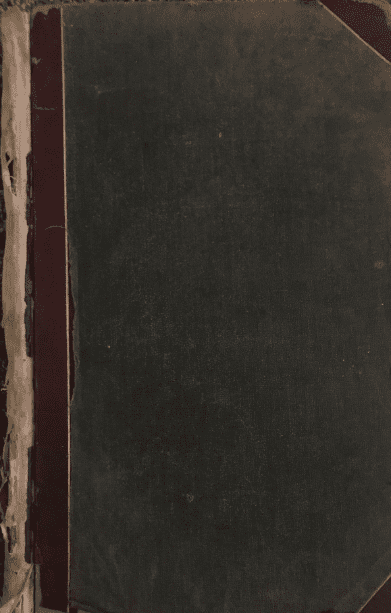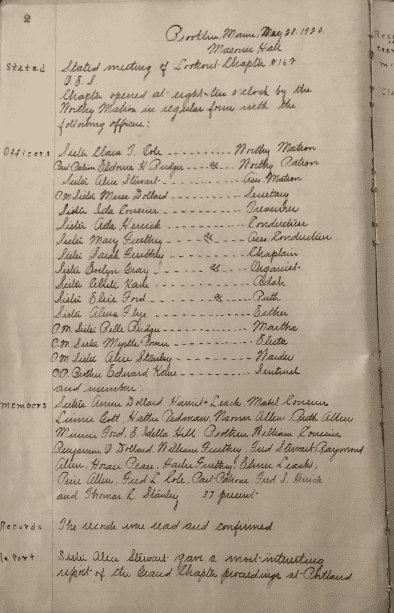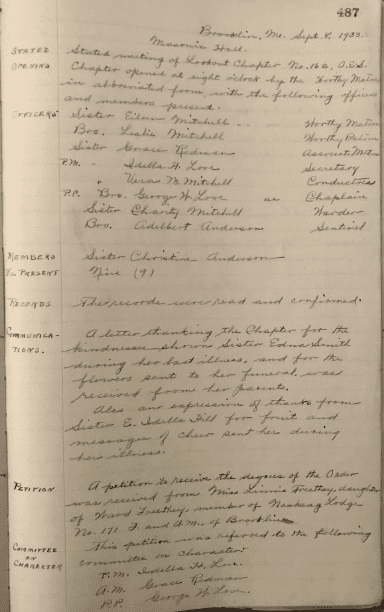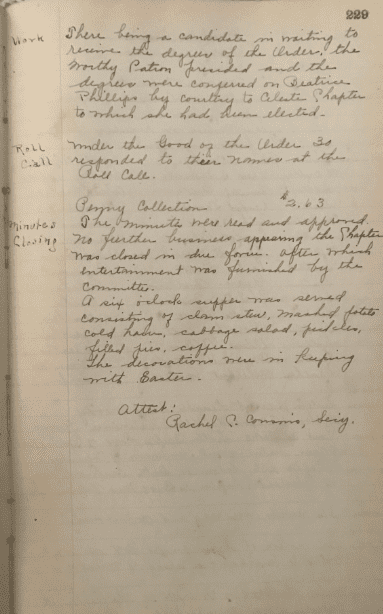Introduction: In this article, Gena Philibert-Ortega writes about an often-overlooked source of family history information: membership records. Gena is a genealogist and author of the book “From the Family Kitchen.”
A seldom used record type in genealogical research are membership organization records. Why are they seldom used? It’s understandable that most researchers don’t spend the time to identify their ancestor’s membership groups. In addition, these records, if they still exist, are most likely housed in an archive – which may mean they are more difficult to find.
Because archival records are not indexed (like subscription genealogy website databases) and most likely not digitized, archival research requires more time and effort via on-site research either by the researcher themselves or a nearby paid researcher. But even with those barriers, membership records can provide important genealogical information and should be considered as you research your family history.
To get a better sense of what membership records might offer your genealogical research, let’s take a look at an example from a meeting ledger of the Lookout Chapter of the Order of the Eastern Star (Brooklin, Maine). This ledger spans the years 1920-1933 in a bound 500-page book. This is just one example of a type of membership record you may find in an archive. (1)

Order of the Eastern Star (OES)
Before I provide examples of the genealogically relevant information in this ledger, let’s briefly go over what the Order of the Eastern Star (OES) is. According to the website for the Grand Chapter of Maine Order of the Easter Star:
“The Order of the Eastern Star is the largest fraternal organization in the world to which both men and women may belong. Worldwide, there are currently more than 1.2 million members… Although not a part of the Masonic fraternity, membership is based on a Masonic affiliation or relationship, a belief in God, and a desire to acquire additional knowledge and self-improvement… The personal welfare of our members is vital to all of those in the Eastern Star, and it is considered a privilege to help another member whenever we can.” (2)
From the Grand Chapter of Maine Order of the Eastern Star website, it appears that the chapter documented in this ledger from Brooklin is no longer active. Searching online for Brooklin, Hancock, Maine, I discover that it is a town with only about 810 residents currently and it was the one-time home of Charlotte’s Web author E. B. White beginning in the 1930s. (3)
Members’ Names and More
This ledger is a record of meetings the OES chapter had over a span of 13 years, and as such it includes the names of everyone who attended each meeting, including guests. Those who held a position within the chapter are listed by their name and position title. Those visiting are often noted with the OES chapter to which they belonged.

If we were researching the individuals listed in this ledger, we could extend our research to include other records such as the U.S. Federal Census. The first page of the ledger lists Clara T. Cole as the “Worthy Matron” (a leadership position in the OES), and further down the page, member Fred L. Cole is listed as well. Looking at the 1920 U.S. Federal Census for Brooklin, Maine, we find the Fred L. Cole family with wife Clara along with their children. Further reading of the ledger’s contents would provide us more information about what Clara and Fred did in the years the ledger covers and would fill in the gaps between census years.

Family and Death
OES members who died are listed in the ledger, though their death dates are not always documented. In this example of Naomi Allen, she is listed as being present for the 23 November 1922 meeting, but just five days later on November 28th a special meeting was called for “paying our last respects to the memory of our sister Naomi Allen.” Then “a recess was declared while the members attended services and marched to the cemetery.”

Because the Order of the Eastern Star includes male and female members, it’s a great resource for female ancestors as well as familial relationships. Families are represented in this volume, especially husbands and wives who are members. But I also found mentions of women with their father’s names, as in this example naming Linnie Freethey as the daughter of Ward Freethey. Other family relationships are most likely represented in this volume as well.

Social History
Taking the time to read the entries provides a snapshot of life in a specific time and place. Searching for social history helps us better understand our ancestor’s life and provides more interest in our family history narrative. For example, it’s probably no surprise that this group enjoyed refreshments at their meetings, but there are a few times where the exact menu is supplied – like the meeting on 9 April 1926 which fell just five days after Easter. They served a 6 p.m. supper with “clam stew, mashed potato, cold ham, cabbage salad, pickles, filled pies, coffee.” There’s also this note: “The decorations were in keeping with Easter.”

Not Everything Is Online
Records beyond the familiar can provide unique perspectives and genealogically rich details. This is just one example of what can be found when we search archives. Archival materials have genealogical relevance but they require more “work” than simply searching an online database. To get started, search archival catalogs for the place your ancestor lived, as well as the catalog ArchiveGrid.
Genealogy is much more than just filling in a family tree with names and dates. To get to know our ancestors, we need to find their stories. The pages of old newspapers, such as GenealogyBank’s Historical Newspaper Archives, contain our ancestors’ stories. And, as this article has shown, other sources – such as membership records – can provide further details to flesh out the stories of our ancestors’ lives.
_________________
(1) This ledger is something I bought at a vintage paper fair, but normally you would find it in an archival collection.
(2) “What is Eastern Star?” Grand Chapter of Maine Order of the Eastern Star (https://maineoes.org/about-us: accessed 22 July 2019).
(3) “Brooklin, Maine,” Wikipedia (https://en.wikipedia.org/wiki/Brooklin,_Maine: accessed 22 July 2019).
